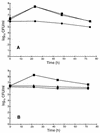Growth and survival of Helicobacter pylori in defined medium and susceptibility to Brij 78
- PMID: 9574682
- PMCID: PMC104805
- DOI: 10.1128/JCM.36.5.1232-1235.1998
Growth and survival of Helicobacter pylori in defined medium and susceptibility to Brij 78
Abstract
The gastrointestinal pathogen Helicobacter pylori requires supplementation with either fetal calf serum (FCS), bovine serum albumin (BSA), or (2,6-dimethyl)-beta-cyclodextrin (CD) for growth in a complex or defined medium. Because the availability of medium in which all components were chemically defined would facilitate metabolic studies of H. pylori, growth of the type strain, ATCC 43504, was compared in a defined medium with different growth additives. The dependency of H. pylori growth on FCS or BSA in a defined medium could partially be replaced by dependency on CD and cholesterol when the last two components were both added to the defined medium. Growth and cell yield were not affected by the addition of glucose, but the culture viability (numbers of CFU per milliliter was extended. Because therapeutic antifoams are used to relieve gastrointestinal symptoms we studied whether the unique susceptibility of H. pylori to the emulsifier polyoxyethylene-20-stearylether (Brij 78) was growth dependent or medium specific. The bactericidal activity exerted in buffer at pH 5 was independent of the preculture medium, and a 5-h exposure of the bacteria to 1.28 to 2.56 microg of Brij 78 per ml reduced the numbers of viable bacteria by >5 log10. The MICs (0.16 to 0.32 microg/ml) were lower than the corresponding minimal bactericidal concentrations in different growth media and were affected by FCS or BSA. In conclusion, CD plus cholesterol promotes the growth of H. pylori in a serum-free defined medium in which glucose enhances cell viability. The antibacterial activity exerted by Brij 78 is neither growth dependent nor medium specific.
Figures





Similar articles
-
Helicobacter pylori growth and urease detection in the chemically defined medium Ham's F-12 nutrient mixture.J Clin Microbiol. 2001 Nov;39(11):3842-50. doi: 10.1128/JCM.39.11.3842-3850.2001. J Clin Microbiol. 2001. PMID: 11682496 Free PMC article.
-
Basis for the selective antibacterial activity in vitro of proton pump inhibitors against Helicobacter spp.Antimicrob Agents Chemother. 1997 Aug;41(8):1797-801. doi: 10.1128/AAC.41.8.1797. Antimicrob Agents Chemother. 1997. PMID: 9257764 Free PMC article.
-
Growth medium containing cyclodextrin and low concentration of horse serum for cultivation of Helicobacter pylori.Microbiol Immunol. 1994;38(11):897-900. doi: 10.1111/j.1348-0421.1994.tb02143.x. Microbiol Immunol. 1994. PMID: 7898389
-
Perspectives on methodology for in vitro culture of Helicobacter pylori.Methods Mol Biol. 2012;921:11-5. doi: 10.1007/978-1-62703-005-2_3. Methods Mol Biol. 2012. PMID: 23015486 Free PMC article. Review.
-
A short review, effect of dimethyl-β-cyclodextrin on the interaction between Helicobacter pylori and steroidal compounds.Heliyon. 2021 Apr 11;7(4):e06767. doi: 10.1016/j.heliyon.2021.e06767. eCollection 2021 Apr. Heliyon. 2021. PMID: 33912723 Free PMC article. Review.
Cited by
-
Helicobacter pylori Biofilm Formation and Its Potential Role in Pathogenesis.Microbiol Mol Biol Rev. 2018 May 9;82(2):e00001-18. doi: 10.1128/MMBR.00001-18. Print 2018 Jun. Microbiol Mol Biol Rev. 2018. PMID: 29743338 Free PMC article. Review.
-
Peptide transport in Helicobacter pylori: roles of dpp and opp systems and evidence for additional peptide transporters.J Bacteriol. 2007 May;189(9):3392-402. doi: 10.1128/JB.01636-06. Epub 2007 Feb 23. J Bacteriol. 2007. PMID: 17322309 Free PMC article.
-
Evaluation of different cryoprotective agents in maintenance of viability of Helicobacter pylori in stock culture media.Braz J Microbiol. 2010 Oct;41(4):1038-46. doi: 10.1590/S1517-838220100004000023. Epub 2010 Dec 1. Braz J Microbiol. 2010. PMID: 24031584 Free PMC article.
-
Growth of Helicobacter pylori in medium supplemented with cyanobacterial extract.J Clin Microbiol. 2003 Dec;41(12):5384-8. doi: 10.1128/JCM.41.12.5384-5388.2003. J Clin Microbiol. 2003. PMID: 14662915 Free PMC article.
-
Proteome analysis of secreted proteins of the gastric pathogen Helicobacter pylori.Infect Immun. 2002 Jul;70(7):3396-403. doi: 10.1128/IAI.70.7.3396-3403.2002. Infect Immun. 2002. PMID: 12065478 Free PMC article.
References
-
- Ansorg R, Müller K-D, von Recklinghausen G, Nalik H P. Cholesterol binding of Helicobacter pylori. Zentralbl Bakteriol Parasitenkd Infektionskr Hyg Abt 1 Orig. 1992;276:323–329. - PubMed
-
- Blaser M J. Helicobacter pyloriand the pathogenesis of gastroduodenal inflammation. J Infect Dis. 1990;161:626–633. - PubMed
-
- Chalk P A, Roberts A D, Blows W M. Metabolism of pyruvate and glucose by intact cells of Helicobacter pylori studied by 13C NMR spectroscopy. Microbiology. 1994;140:2085–2092. - PubMed
-
- Chan W Y, Hui P K, Chow J, Kwoki F, Ng C S. Coccoid forms of Helicobacter pyloriin the human stomach. Am J Clin Pathol. 1994;102:503–507. - PubMed
MeSH terms
Substances
LinkOut - more resources
Full Text Sources
Other Literature Sources

